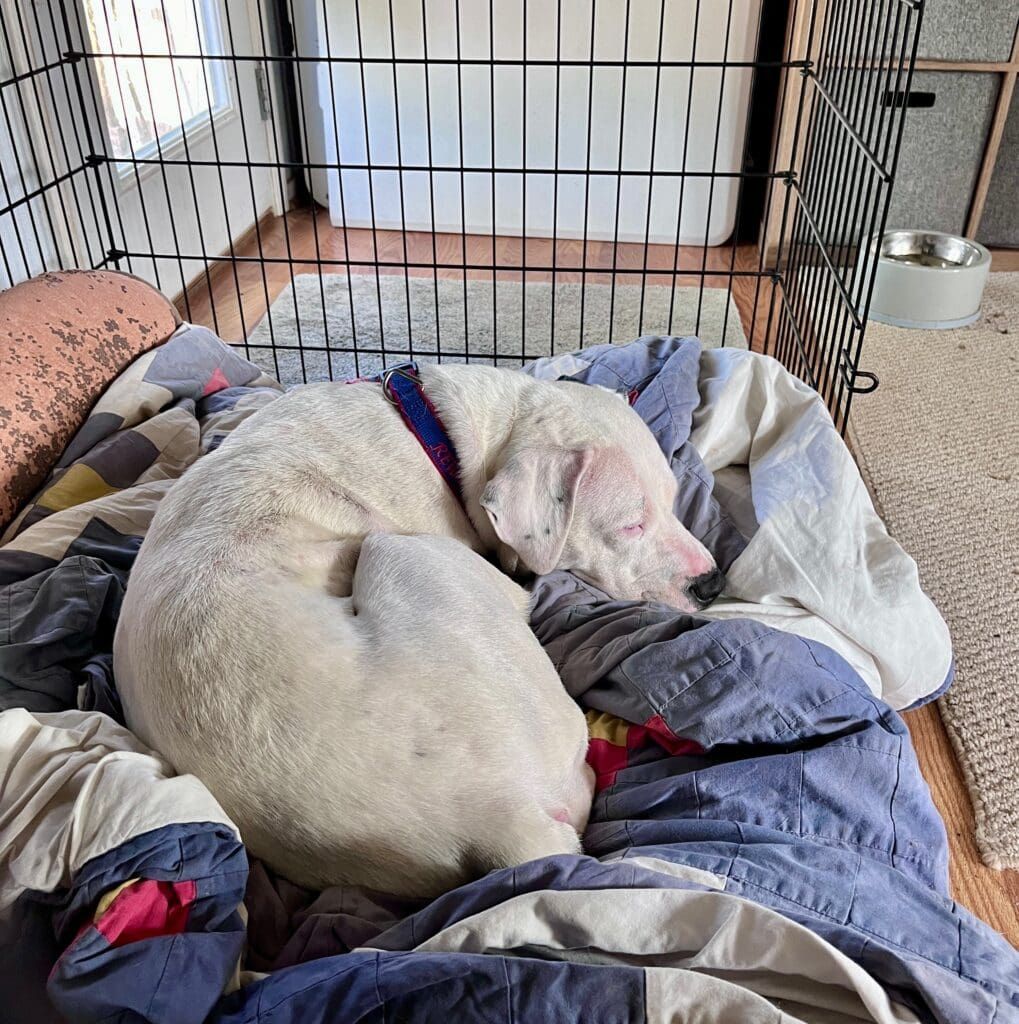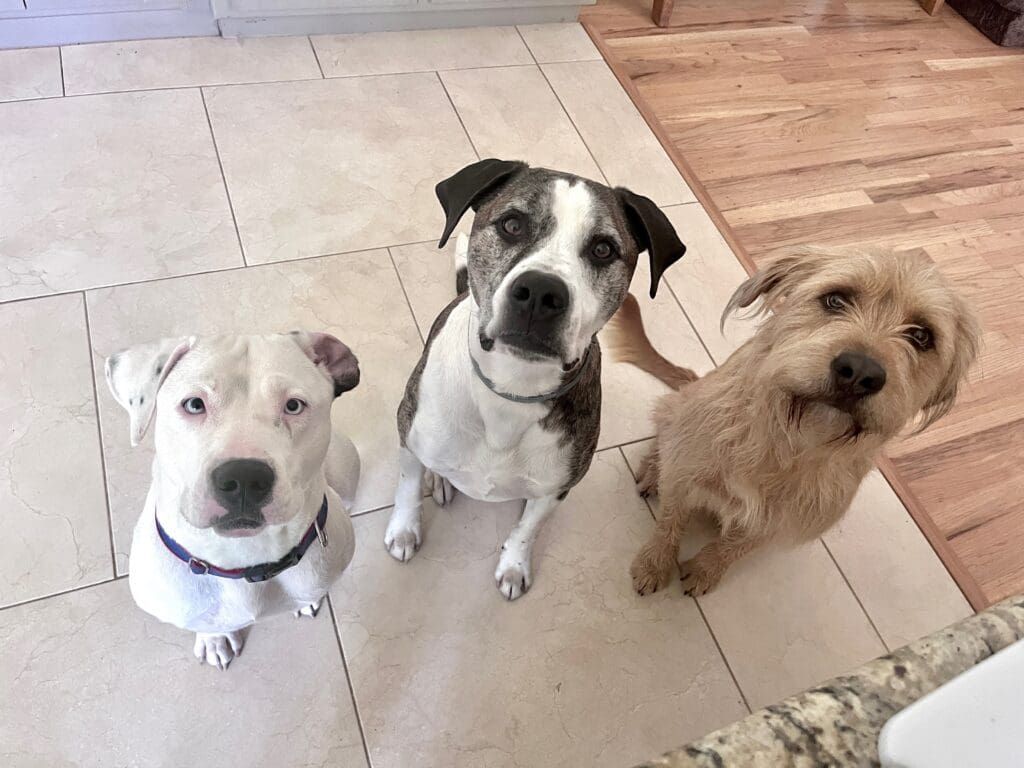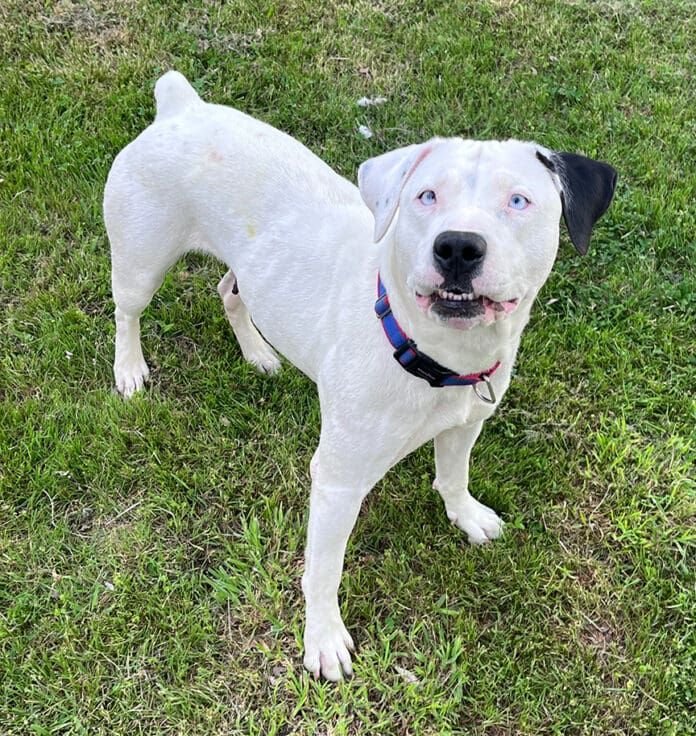Perhaps the best alternative I’ve ever seen to rehoming dogs through shelters is called a home-to-home model – which is a new and ideal name for what rescue groups have been doing forever, but which more fully describes the ideal experience for the dogs.
When someone can’t keep their dog – for whatever reason – instead of surrendering the dog to a shelter, a rescue group takes on the responsibility for caring for the dog until its members can find a new home for the dog. While in the rescue group’s custody, the dog is fostered in a group member’s home – and during the dog’s stay in a home, the group can both learn more about the dog (in order to make the most suitable placement) and teach the dog any family-dog skills the dog may not currently possess.
I am currently fostering a dog from my local shelter in an effort to thoroughly assess her suitability for a home with a 90-year-old woman, who is a friend of one of my elderly neighbors. Why, you might ask?
My neighbor walks by my house almost daily, sometimes with her also elderly sister and sometimes with an elderly friend. All of these people are dog lovers who no longer have dogs; all of them are in their 80s, and all of them have expressed to me that they feel too vulnerable to tripping on or being knocked over by a dog. Nevertheless, they love to visit with my dogs over the fence, and they are all alert to the appearance of any foster puppies or dogs on my property; they will stop by the fence, wait for my dogs to bark and me to emerge from my office, so they can wave me to the fence and ask to meet the newcomers. They especially love it when I have puppies that they can hold and kiss and fuss over.
My neighbor called me recently to ask for a favor. One of her friends, Ursula, lost her husband of 50-plus years a few months ago. Ursula and her husband had always had a large dog, but their last dog died a month or two after her husband died. Her friend, she said, was desperately lonely and wanting another dog, and had gone to my local shelter with a 50-something-year-old niece to look at prospects – and they came home with a 9-month-old Labrador-mix puppy. (I’d love to know which shelter employee made that adoption; I’d like to have some words with them!)
Needless to say, Ursula decided within a day that she needed to bring the puppy back to the shelter, as the puppy had WAY higher exercise needs than she was going to be able to provide – but she cried for days, my neighbor told me, she felt so bad about having to bring the puppy back. My neighbor said, “Could you please help Ursula find a nice older dog to keep her company?”
Of course!
When I called Ursula to discuss her quest for another dog, she begged me to come to her house so I could see what amount of home yard space she had and look at the fences, so I could see how and where the dog would live. I was happy to see that there were baby gates permanently installed at various doorways around the house. “Oh yes,” she said, “We’ve always put the dogs behind this gate when we ate meals, and behind that gate when guests arrived. Otherwise, they have the run of the house,” Ursula told me. The house had a nice fenced yard and sunny deck, both accessible from a back door that could be kept open on nice days for a dog to go inside and out, and which could be easily opened for a house-trained dog to “go” outside whenever needed.
Ursula also showed me the big, thick dog bed her last dog (a Boxer/Shar Pei-mix) used in the living room and the nice raised bowl set he had used when his arthritis prevented him from eating and drinking from bowls on the floor. She also showed me some statuettes of dogs that resembled the four dogs (the Boxer-mix, two Boxers, and a Cocker Spaniel) whose lives had spanned her long marriage to her husband and several framed pictures of all of them. It seemed like a great setup for a dog and she seemed like a very caring, knowledgeable dog owner, 90 years old or not! My only concern: Ursula really wants a medium-to larger sized dog. She says she’s never particularly liked small dogs; she’d love to have another Boxer.
Why a home-to-home foster is critical
Here’s the thing: Sending almost ANY dog straight from a shelter into this woman’s home is setting up her and the dog for failure! Dogs who have grown up in the shelter are unlikely to have any housetraining, and while this isn’t rocket science to accomplish, it might be difficult for someone at that age to clean up any accidents on carpets. If the dog isn’t trained to wait politely at doors or for meals, he may knock excitedly into his new owner and cause a devastating fall. If he’s fearful of strange humans, he may prevent her friends from visiting, or emergency responders (if ever needed) to help her in time! There are so many potential hazards presented by a dog to someone who lives alone at that age! But also, so many potential gifts…. So, yes, I’m helping her find a dog. And what she needs is a dog who is already habituated to live in a home, housetrained, friendly, and calm. And it’s very difficult to find a dog who meets that description in a shelter!
I contacted a friend, Lynee, who works at the shelter; I’ve written about her before, she’s a former volunteer who got hired to provide enrichment and get dogs outside. I asked her if she had any suggestions for a medium-to-large dog for a 90-year-old, and she suggested Angel.

I went to the shelter to meet Angel, and I have to admit, I wasn’t wild about the idea at first, even though her size is perfect (she weighs maybe 45 pounds, though she could use a little more meat on her prominent bones) and her age is good (she’s estimated to be about 3 years old). She’s some sort of bully-breed-mix, with a naturally bobbed tail and queer-looking blue eyes with asymmetrical irises. She didn’t seem immediately as focused on receiving attention and petting from humans as I would like a companion for a lonely senior citizen, but she was calm and good on the leash, so I took her home for a more thorough evaluation.
Before I send this dog – or any dog! – into this nice woman’s home, I need to know that she’s going to fit in almost seamlessly. I want to know that she’s unambiguously friendly and affectionate to humans (familiar people and strangers alike, in case Ursula needs help from anyone at any time), not spooked by household events or sounds (like the TV, vacuum, microwave, loud phone answering machine, and so on), patient and not grabby about food, and housetrained! I want to make sure she’s comfortable and patient with being leashed, handled, petted, and brushed, and that she can (and will) get into and out of a car easily, in case she needs any vet or groomer appointments. I also think it’s important that she is capable of being alone in her new home without causing any damage or getting overexcited when Ursula arrives home from any doctor’s appointments or trips she takes to the market. That’s a tall order! And a lot to expect from any dog right out of the shelter.
And yet, so far, Angel is passing all my tests with flying colors, and what she doesn’t know, she is learning quickly. At least once an hour, I think to myself, “Whew! I’m so glad I know that Angel can handle that situation!” (These experiences have included our lawn tractor backfiring loudly, my accidentally dropping a pan on the kitchen floor, and my grandson accidently landing partially onto her when he jumped over the back of the couch, not knowing she was there).

Not all families need a dog to be this perfect; fortunately, many people who want to open their homes and hearts to a rescued dog are able to accept and cope with the dog’s lack of knowledge, and take the time to help the dog learn how to live with humans. But I can’t think of a better way to ensure a successful adoption than for an experienced dog owner to foster the dog first – if only to be able to provide the adopters with information and reassurances about the dog’s character and behavior, and suggestions for dealing with any problems that might arise. If you can possibly foster dogs for a shelter or rescue group, I implore you to give it a try.
Suggested reading about fostering:
Interested in Fostering? Protect Your Foster Dog – And Your Heart






Please keep us updated on Ursala and Angel! I would love to hear of (and see pics) their happy ending!